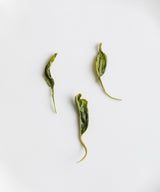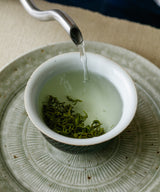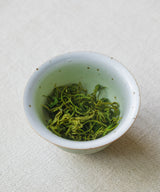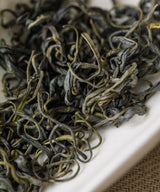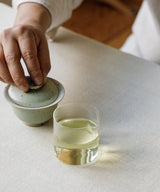High Mountain Green 2025
峨眉黑苞山炒青
Harvest
April 8, 2025
Origin
Hualong Village, Heibaoshan, E'Mei, Sichuan
We suspect that if pandas were to drink tea, this would be it. Heralding from the natural habitat of the great panda, a fresh harvest of our delicious High Mountain green tea has arrived to us from the peaks of E’Mei. Every year, this tea ends up being people’s Spring favourite, and we are sure this year will be no exception. Its tiny, coiled leaves are unmistakable, and this year we see especially rich and mottled colours in them, as though the palate of an entire rainforest has pooled at the bottom of the gaiwan.
We are so pleased with the balanced taste of this year’s harvest. It has enough body to meet you in whatever state you are in, making it great for daily drinking, or enjoying alongside other activities, while also having enough complexity to bring us further into the present moment. It invites our attention by being delicious, refreshing, and soothing, while at the same time simplifies us by being sweet and resolved. Its harmonizing effect may even evoke some panda-like qualities in you, which we can only think to be a positive thing.
. . .
There is a mythical mountain in Sichuan province. For many people, it is a household name that, when spoken, evokes an air of the otherworldly. This place is called E’Mei 峨眉.
There are four sacred buddhist mountains in China, E’Mei being one of them, and the highest peak. It is home to more than seventy ancient temples and is regarded by Buddhists as the place of enlightenment. Many people will know it for the well established community of monkeys that reside amongst the temples and engage with visitors of the mountain.
Tea cultivation on E’Mei dates back to the Tang Dynasty, when fresh teas from its peak were delivered to the imperial palace as Tribute Teas to the Emperor. Our High Mountain Green comes from Heibao Mountain, near Haulong Village at upwards of 3200 ft above sea level. This area, central to E’Mei, is the primary area for producing tea on this mountain – almost all the tea gardens here consist of old tea trees, planted generations ago.
The soil in Heibao is formed from porous volcanic ash, providing ideal minerals and drainage for tea trees. The elevation means that Haulong Village and the surrounding area is nearly always covered in rain or fog. It is a place that, while feeling quite unchanged, has some enchanting adaptations. 20 years ago many fruit trees were planted in and around the tea gardens here. Now the tea grows in the dappled shade of fragrant loquat and peach trees. However unusual this is, the tea benefits from their proximity, and is said to smell like flowers on account of it.
This tea is made from leaves from the first picking of the season, consisting of one bud and two leaves. This results in a richer taste – in this case, deep in flavours reminiscent of flowers and seeds – which is in line with local preference. Regionally, this tea is simply referred to as 炒青 “pan-fried green.”
. . .
Brewing guide
| Tea | 3g |
| Temperature |
80 °C |
| Water | 120ml |
| Steep time | 5 - 90 sec |
| No. of infusions | 8 |

